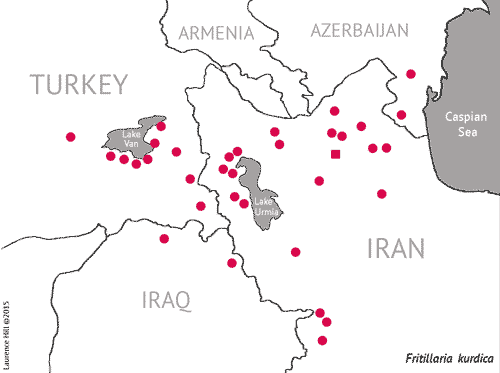Fritillaria kurdica
History
Fritillaria kurdica was described by Boissier from specimens collected by Noë near Lake Van in the late 1840’s. Friedrich Wilhelm Noë, an Austrian, was born in Berlin in 1798. In 1844 he settled in Istanbul and became director of the Botanic Garden of the Êcole Impériale de Médicine de Galata Serai. Most of his expeditions were made in the years up to 1854, and he died in Istanbul in 1858. The school at Galataseray, now Galatasaray Lise, was founded by the Sultan Beyazit II in the early 16th century, as the palace school for royal pages and future administrators of the Ottoman empire, initially drawn from the sons of Christian captives, but later including Turkish boys.
Even earlier collections had been made, in 1829, by Johann Nepomuk Szovits, an Hungarian, who worked as a pharmacist in Odessa; he made collections in the Caucasus, Armenia and Azerbaijan in 1829 and 1830, and died at Kutaisi in Georgia in 1830, though under what circumstances I have been unable to discover. His specimens, however survive in the Herbarium in St Petersburg, and he is remembered both by a species of Lilium and a Colchicum.
The combination Fritillaria crassifolia subsp. kurdica was made by the author in 1974 as part of a revision of Fritillaria, leading up to the publication of Davis’s Flora of Turkey, volume 8 (1984). Tekşen raised it back to species level in the Illustrated Flora of Turkey (2018).
Recognition and minor variation
Fritillaria kurdica has 5–7 lanceolate, somewhat glaucous leaves, and usually brown or blackish tessellated flowers with a green stripe along the centre of each tepal; its linear nectary usually has raised ridges on each side. The ground colour of the flowers varies and may be either green or yellowish. In the Van area, where it is particularly common, and westwards, the ground colour is generally green; in Hakkari and in northwest Iran and Azerbaijan, the ground colour is more often yellow, and the stems are often taller, and it is in this area that the plants described as Fritillaria karadaghensis Turrill are found. This form was illustrated in Curtis’s Botanical Magazine t. 9303 (1933).
The plants of F. kurdica, grown by Rod Leeds, which are illustrated in Curtis’s Botanical Magazine t. 396 (2000), are a beautiful pale yellow form which lacks anthocyanin. A similar mutation is known in several other species, and produces clones which are much sought after by gardeners. So far these yellow forms have been recorded in F. pyrenaica, F. acmopetala, F. amana ‘Goksun Gold’, F. michailovskyi, F. rhodocanakis, and F. reuteri. Among American species it is found in F. purdyi and F. affinis. Similar lack of anthocyanin in F. meleagris and F. tubiformis produces white flowers.
F. kurdica can be distinguished from F. crassifolia by its narrower leaves, and by its nectarines, which lie in a swollen ridge down the centre of the tepal. F. hakkarensis differs in its narrower, shining green leaves, and smaller, mainly green flowers. F. graeca Boiss. & Sprun., or at least the smaller forms of it, can also be similar, but have shorter nectaries, also without the raised ridge.
Subspecies, varieties and synonyms
It is not surprising that such a variable, widespread and common plant as F. kurdica should have several synonyms. Fritillaria karadaghensis Turrill was described from cultivated plants collected by Egger on Karadagh in the Tabriz area, and grown in Tabriz; Turrill himself acknowledged, after seeing material of subsp. kurdica, that the two were very close. F. foliosa Bornm. was described from the same Egger collection or another collection by Egger from the same area.
Fritillaria grossheimiana A. Los. was described from exactly the same area, but has dark flowers with a yellow tip. This is very similar to garden hybrids between F. michailovskyi and subsp. kurdica, and similar plants were collected in the same area on Kuh-i-Sahand by Paul and Polly Furse (PF 2333, 2923). It is perhaps worth recognising this distinct colour form as F. grossheimiana (A. Los.) Rix.

Geography, distribution, habitat and pollination
Fritillaria kurdica is found in south-easternTurkey, Azerbaijan, north-western Iran and northern Iraq. It generally grows in open steppe and earthy and stony hills and rock ledges, usually on north-facing slopes, at 1500–3500m. In Turkey it grows with a wonderful range of bulbs which includes Allium akaka, Iris pseudocaucasica, Iris sari, Iris aucheri, Iris reticulata, Tulipa violacea, Puschkinia scilloides, Ranunculus kochii, Astragalus species (often dominant), and elsewhere Eryngium billardieri, Prangos spp., Ferula spp. and other large Umbelliferae. It is common at 1800–2000m from Muş eastwards along the south of Lake Van to Van itself, and from there through Hakkari to Iran and northern Iraq.
In Iraq it has been collected mainly around Haji Umran between Rowandiz and Mahabad while in Iran it is recorded as far south as betwen Marivan and Sanandaj. It appears especially common around Rezaiyeh and around Tabriz. In Azerbaijan it is found both in the Talysh and through Nakhichevan to Armenia in the hills around Lake Sevan.
Near Tabriz, on the shoulders of Kuh-i-Savalan we collected the following species in the same habitat: Scilla miczenkoana, Iris reticulata, Tulipa sp., Colchicum sp., and a tuberous Delphinium.
Paul Furse saw and photographed a queen wasp emerging from a flower of F. grossheimiana in northern Iran; this picture is reproduced in Iran Journal of Botany 1 (2): 87(1977). Wasp pollination is common in the brown and green flowers of this group in cultivation.
F. kurdica Boiss. & Noë in Boiss. Diagn. ser. 2(4):103(1859).
Synonym:
F. crassifolia subsp. kurdica (Boiss. & Noë) Rix in Kew Bull. 29:638(1974).
F. wanensis Freyn in Bull. Herb. Boiss. ser. 2,1:287(1901).
F. karadaghensis Turrill in Gard. Chron. ser. 3, 85:242(1929).
F. foliosa Bornm. in Feddes Repert. Sp. Nov. 27:338(1930).
F. grossheimiana A. Los. in Komarov, Fl. U.R.S.S. (addendum 3) 739(1935).
Description
Bulb to 3cm across, usually without bulbils. Stem 3–10cm. Leaves usually 5–6, lanceolate or linear-lanceolate, the lowest 3–5cm x 6–15mm, 3–5 times as long as wide, all alternate, glaucous. Flowers usually 1 or 2, rarely to 4, broadly campanulate, yellowish or green, usually tessellated and stippled with brown or purple, with fascia, with a spermatic scent. Tepals 1.7–2.0cm, the outer 5–8mm wide, the inner 8–12mm wide, obtuse. Nectaries often blackish at the base, linear, 8–10mm long, 1mm wide, 3–5mm above the tepal base, on a raised ridge. Filaments 5–7mm, papillose; style 5–8mm, the branches 3–4mm, slender, smooth. Capsule not winged, rounded or shortly cylindrical, tapering towards the base.
Distribution: South-eastern Turkey, Azerbaijan, north-western Iran and northern Iraq
Chromosome Number: 2n = 24.
Type: Turkey: in subalpinis prope Van, Noë 5 (G.).
Habitat: growing on rocky slopes and earthy steppes at 1500–3500 m
Flowering period: April to July, but mostly in May
Cultivation: In cultivation of Fritillaria kurdica is not difficult in well-drained sandy soil; the plants should be kept as cool as possible, and kept in full sun as soon as they emerge in spring to retain their typical dwarf habit; cultivation in a frame is therefore better than in a greenhouse. Rich feeding and too much warmth in cultivation produce leggy and atypical plants, which collapse at flowering and are susceptible to botrytis. Propagation must be by division of the bulbs in summer or by seed.
Extract from Martyn Rix’s forthcoming Monograph ©2008
![]()


